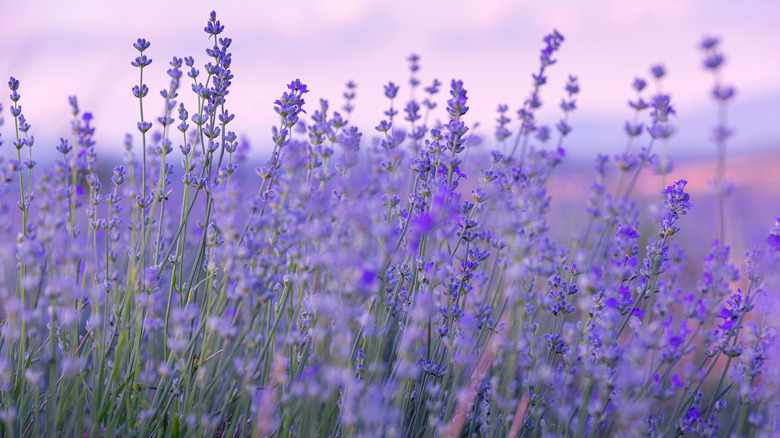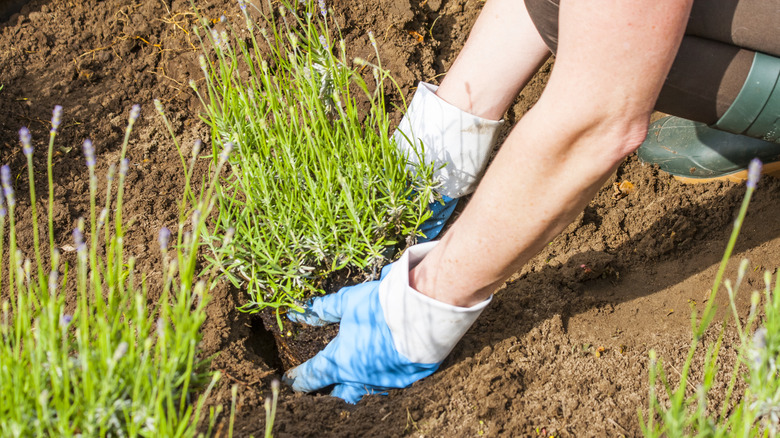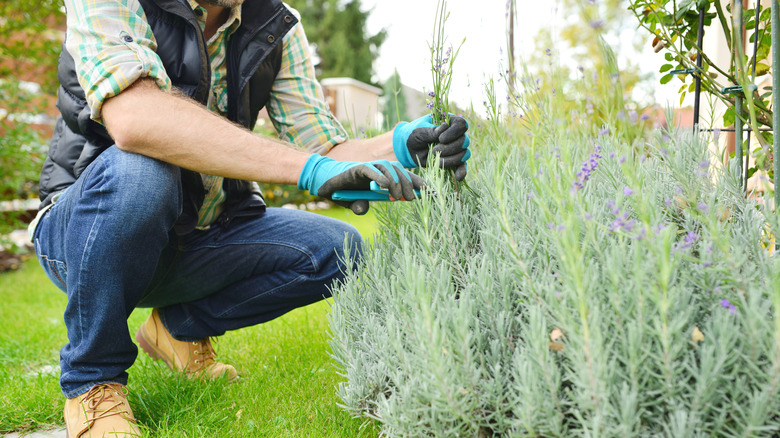How To Easily Grow Lavender For An Endless Supply Of Dazzling Purple Flowers
From oils and perfumes to delicate dessert flavoring, lavender holds a special place in the hearts (and noses) of many. Its recognizable scent is a staple in bath products, relaxing teas and home fragrances, and may even help naturally repel pests. It's often grown for the express purpose of harvesting the buds before they open. But, when left to flower, this easy-to-grow perennial shrub is a pollinator magnet. By pairing different varieties of lavender together and following best pruning practices, you can create a vibrant show and an endless supply of dazzling purple flowers that last from spring to fall.
Lavender (Lavandula spp.) is an evergreen, mounding genus in the Lamiaceae or mint, family. Native to Mediterranean climates, it's been grown for centuries as a medicinal, culinary, and cleansing plant. Even its name, which is rooted in the Latin word "lavare," meaning "to wash", illustrates its longstanding use to scent soaps. But with hundreds of varieties, cultivars, and hybrids, the genus has also gained notoriety for its place in showy flower gardens.
While English lavender (Lavandula angustifolia), may be the most common variety for commercial planting and harvesting, it's just one of many. Home gardeners looking to extend their bloom season often turn to French Lavender (Lavandula dentata), Spanish lavender (Lavandula stoechas), or lavandin (Lavandula x intermedia) varieties for their differently shaped blossoms and staggered growth. When paired together and cared for correctly, these blooms can remain a fixture in your garden all season long.
What your lavender needs to thrive
Regardless of the variety, lavender is a fairly easy plant to grow. Most species of English lavender and lavandin hybrids are hardy in USDA Hardiness Zones 5 through 9 and remain evergreen through cold winters, giving them a year-round appeal. French varieties often prefer the warm, dry climate in zones 8 through 11, while Spanish lavender finds its sweet spot in zones 8 and 9. All varieties prefer slightly dry, well-draining soil, and will not tolerate dense clay, or heavily saturated areas. But with significant drought tolerance and little need for fertilizer, lavender is a low-maintenance option for any garden.
Reaching 1 to 3 feet tall (including blooms), most lavenders do well when planted as mounding shrubs or border plants in perennial flower beds. The woody stems host masses of thin, silvery-green leaves that may appear serrated or even fern-like on some varieties. Heat tolerance varies between species, with some flowering quickly as the temperature rises. With so many different varieties of lavender to choose from, it can be hard to find the right combination to keep your garden buzzing throughout the year. But, by placing your plants thoughtfully and pruning your lavender at the right time, you can keep your yard glowing with purple blossoms for months.
Clever placement and pruning will extend blooms
Since different types of lavender bloom at different times, layering several varieties is a great way to enjoy an endless pop of purple. For early to mid-summer color, choose an English variety. In mild climates, some species may even bloom twice — once in early spring and again in late summer. Lavandin, a hybrid of English and Portuguese lavender, is likely to bloom only once in mid to late summer, so it pairs well with early-blooming English varieties.
Spanish lavender, which is easy to differentiate by its tufted blooms, is extremely drought tolerant and blooms throughout summer, making it a great companion to spring flowering English varieties. French lavender species that prefer warmer climates may bloom later in the summer or early fall. Pairing French and English varieties is a great way to extend your flowering season. If you live in an area where it isn't hardy, you can winterize your lavender to protect it.
Whether you harvest your lavender or leave it to flower, it's important to prune your plants at the right time of year. For most varieties, a good rule of thumb is to prune your plants back by about a third after the blooms fade in fall. Take care not to cut into the plant's woody stems, though, as this may harm or even kill your plant. To encourage a second round of blooms later in the year, English lavender can be pruned back by a few inches after the early spring blossoms fade.


